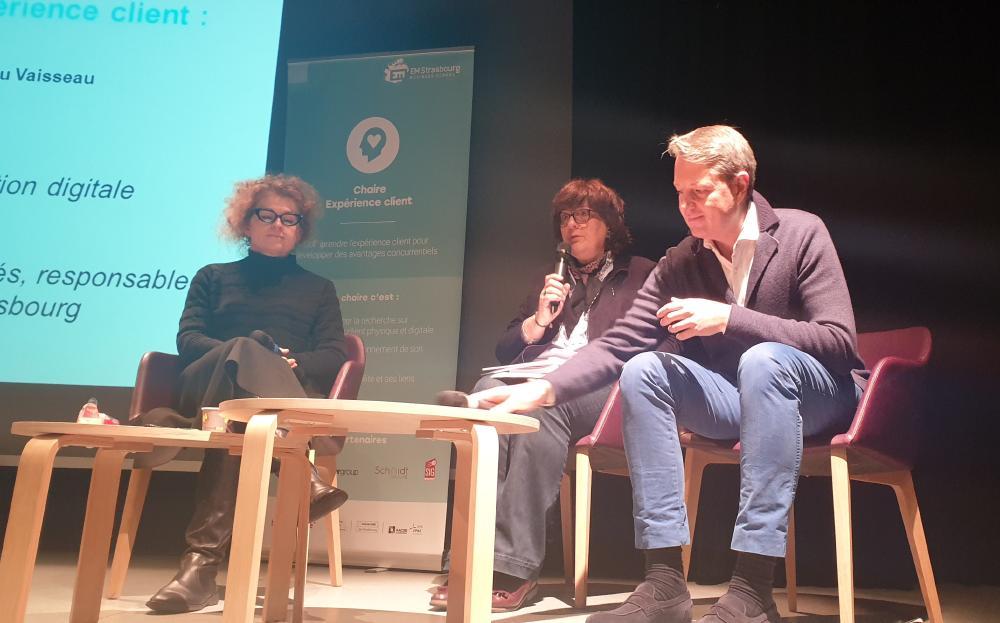
Can improving the quality of working life for employees and optimizing the customer experience be part of the same strategy? Although these two experiences seem diametrically opposed, similarities exist and make it possible to create collaborations within a company. This theme, at the crossroads between human resources and marketing, was the subject of the 2nd conference organized on January 15 by EM Strasbourg Business School’s Customer Experience Chair on the theme: “Employee experience and customer experience, the same battle?”
A Common Platform of Values
The customer experience and the employee experience are, by definition, different but "they must be consistent and have a common set of values", says Anne Leitzgen, CEO of Schmidt Groupe. The two subjects are undoubtedly linked. A poor relationship between the company and its employees will affect the customer experience.
Trust is a fundamental value. On the customer side, trust in the brand and above all in the person they are going to meet during their purchasing process are key vectors in their decision. “Strong regulations in the banking sector can be a barrier to a relationship of trust. Despite this, Crédit Mutuel has been the number one bank in terms of trust for many years”, Reynald Chapuis, Head of Human Resources for digital transformation at Crédit Mutuel Alliance Fédérale, emphasizes. To deal with this, the strategy consists of enhancing the advisory relationship between the account manager and the client. Here, emotion, perception, listening, and discussion will be real assets both in terms of customer and employee experience. On the employee side, expectations are similar to those of customers. “We shouldn’t forget that an employee is also a consumer and a citizen. Within their working environment, they expect a certain number of values in line with the external environment. ”
“Just like the customer, the employee has become a customer and supplier of the brand. The interaction between these two stakeholders is no longer so divided”.
Anne Leitzgen
Transparency is also an important element. Employees’ expectations, fueled by their own experience as customers, are becoming more and more demanding. The emergence of sites such as Glassdoor, “Tripadvisor for companies”, is a good illustration of this symmetry. For Anne Leitzgen, “Just like the customer, the employee has become a customer and supplier of the brand. The interaction between these two stakeholders is no longer so divided”.
Management and HR: Key Players in the Common Platform
For optimal coherence between the two experiences, several professions have taken on particular importance. This is the case for human resources. “HR has become central in terms of complexity and people. This division is at the heart of a company's commitment to its employees. HR is now an integral part of the business,” notes Reynald Chapuis. An employee’s behavioral and interpersonal qualities, which are essential in their relationship with colleagues and clients, are key factors in recruitment.
For companies, improving the quality of life of their employees is also decisive. Conditions that are conducive to human relations must be created. “If a person feels good, they perform better,” says Anne Leitzgen. The role of management is of great importance here. The manager encourages an executive and gives meaning to the work of their teams. They give and inspire confidence. The ability to have dialogues and discussions is a real performance indicator of the employee experience.
“If a person feels good, they perform better”
Anne Leitzgen
In addition to employees in direct contact with the customer, all stakeholders in the company must be taken into consideration in terms of the employee experience and customer relations. “The further away an employee is from the end customer, the more they will question the meaning of they work. These people need to be nurtured by the company's values and to understand what their actions are for. You have to take care of the experience they are going to have,” says Anne Leitzgen. In order to bring these employees closer to the end customer and the finished product, Schmidt Groupe organizes “Live my job” days, among other things.
"The issue of giving meaning to work needs to be addressed in different ways. The manager must have a different reading grid.
Claire Roederer
Showing employees the complete customer experience gives an extra dimension to their work. This confrontation contributes significantly to improving the employee and customer experience. “The whole experience means telling the story of the customer's experience and also that of the employee with a vision of the overall journey. It allows us to measure the both the employee’s and the customer’s level of commitment.”
“The manager must have a different reading grid according to the employee's position and expectations. The issue of giving meaning to work needs to be addressed in different ways. The transmission of values must be more intense according to certain employee profiles”, summarizes Claire Roederer, Associate Professor and Head of the Customer Experience Chair at EM Strasbourg.
What Influence Does Digitization Have?
For both speakers, digital does not replace the human relationship. On the contrary, with digitization, interaction with others returns to the centre of customer relations. The situation is the same within companies. Discussions between employees and finding out about each other's jobs are seen as very enriching experiences. The more digital is present, the more important the need to cultivate human relations becomes. For Reynald Chapuis, “digital has transformed the ability to distribute access to the service. It completes all the paths of the customer and employee journeys”. The ability to have a dialogue becomes a fundamental asset, “a premium element in the customer's journey, but also in the employee's journey. ” Also, support for the employee in terms of the quality of dialogue and empathy is necessary.
See the Replay
